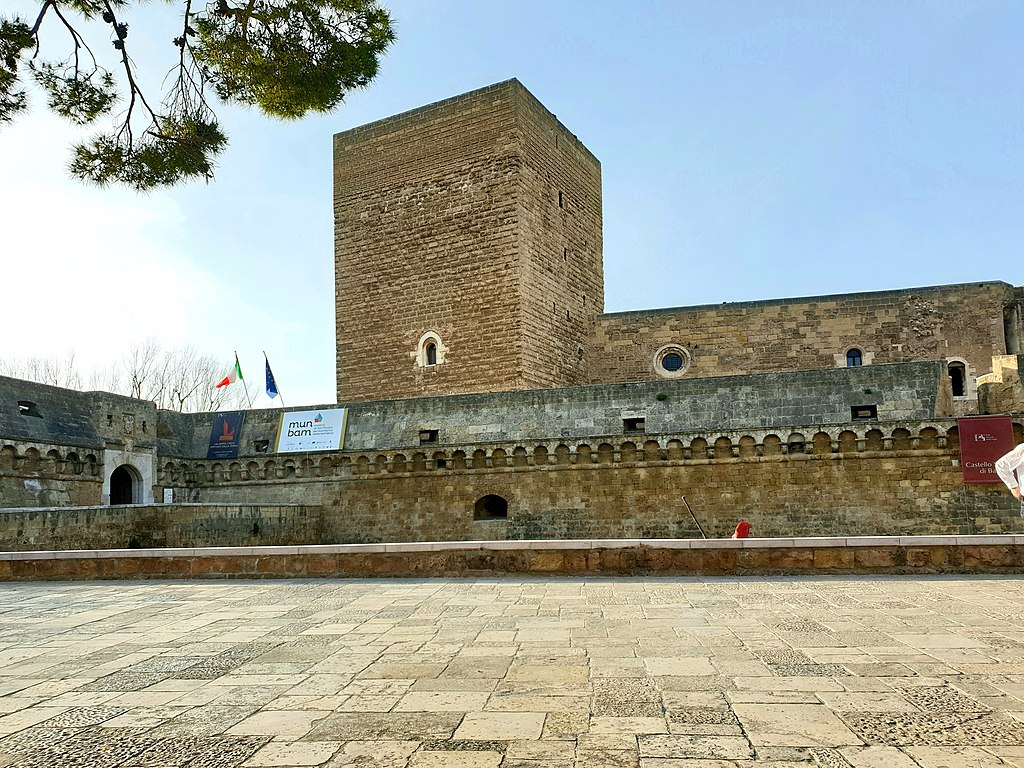With its mighty and severe bulk, the Castello di Bari stands at the far edge of the old city, where it once served as the pivot of the ancient city wall.

Bari, Castello Svevo (photo by Carlo Dani – his own work, CC BY-SA 4.0, https://commons.wikimedia.org/w/index.php?curid=77189036)
The castle of Bari is a manor which contains at least two others inside, as in a game of Chinese boxes. Archaeological evidence has in fact revealed the presence of defensive structures from the Roman era, on whose remains a Byzantine Kastron and other buildings with residential functions were built. On this site it was Roger II of Sicily in 1130 who ordered Saracen workers to raise the castle. The people of Bari have never loved this place, which is such an evident symbol of royal power – and in fact, several times it was demolished by the population over the centuries. With the arrival of the Swabians, and with the frame-up policy desired by Emperor Frederick II, in the first half of the thirteenth century the Norman defensive structure was recovered, after being seriously damaged during the popular riots of the previous century. The mighty quadrilateral building, with a trapezoidal plan equipped with corner towers made of bosses, was softened by single and double lancet windows and by a wonderful Gothic-Federician portal, which was sculpted with anthromorphic and zoomorphic figures, mythological motifs and clearly heraldic symbols inspired by iconography imperial. On the ashlar keystone stands an eagle clutching a lion between its claws, a recurring symbol in Federician architecture.
The vestibule, which can be accessed through the portal, also dates back to this same era and aesthetic sensibility. The environment has a cross-vaulted roof, supported by columns and pilasters with finely carved capitals: a world of stone in which the Gothic Federician naturalism coexists with Islamic suggestions. It is known that among the workers at the service of the emperor there were many Arab artists, craftsmen and stonemasons. Just in the castle of Bari, to testify to the cultural melting pot promoted by the Swabian sovereign, a man called Ismael worked together with the stonecutters Finarro di Canosa and Mele da Stignano; this man left his signature on one of the capitals.
After the Swabians were the Angevins, who wanted to restore the north area of the castle and the reception rooms; despite this the new rulers never stayed in this house, which remained abandoned until the arrival of Isabella Sforza and her daughter Bona in 1524. They are the true ladies of the castle, who made it a luxurious Renaissance residence surrounded by a renewed city wall. Inside of it there were loggias, stairs, halls and frescoes which embellished the severe fort structure. With the death of Bona Sforza, the castle of Bari no longer experienced phases of splendor, but was left to fall into disrepair.
The Swabian castle is not only a building of great historical and architectural value, but the stories related to a legendary meeting between Saint Francis and Frederick II still echo within its ancient walls. It is in fact the episode that tells us how, right in the rooms of the man from Bari, emperor Frederick II forced the poor man of Assisi to struggle with temptations of the flesh, although there is no written evidence for that.
